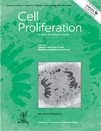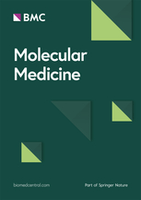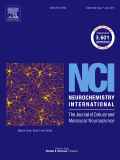
Current Stem Cell Research & Therapy
Scope & Guideline
Empowering Discovery in Stem Cell Research
Introduction
Aims and Scopes
- Stem Cell Mechanisms and Pathways:
Research exploring the underlying biological mechanisms of stem cells, including signaling pathways, differentiation processes, and the effects of various factors on stem cell behavior. - Clinical Applications of Stem Cells:
Studies focusing on the therapeutic applications of stem cells in treating various diseases, including but not limited to neurodegenerative disorders, cardiovascular diseases, and autoimmune conditions. - Stem Cell Sources and Characteristics:
Investigations into different sources of stem cells, such as mesenchymal stem cells, induced pluripotent stem cells, and embryonic stem cells, along with their unique properties and potential therapeutic uses. - Exosomes and Secretome in Stem Cell Therapy:
Research on the role of stem cell-derived exosomes and secretome in mediating therapeutic effects, including their potential in tissue repair and regeneration. - Tissue Engineering and Regenerative Medicine:
Studies involving the integration of stem cells with biomaterials and scaffolds to enhance tissue regeneration and repair in various medical applications. - Safety and Efficacy of Stem Cell Therapies:
Meta-analyses and systematic reviews assessing the safety, efficacy, and long-term outcomes of stem cell therapies in clinical settings.
Trending and Emerging
- Exosome Research and Applications:
There is a growing trend in the exploration of exosomes derived from stem cells, focusing on their roles in intercellular communication and potential as therapeutic agents in regenerative medicine. - Combination Therapies Involving Stem Cells:
Recent publications emphasize the use of stem cells in combination with other therapeutic modalities, such as gene therapy, nanomaterials, and pharmacological agents, to enhance treatment outcomes. - Technological Advances in Stem Cell Research:
The integration of advanced technologies, such as CRISPR gene editing, bioinformatics, and 3D bioprinting, is increasingly being recognized for its potential to revolutionize stem cell applications and tissue engineering. - Personalized Medicine Approaches:
Emerging themes highlight the personalization of stem cell therapies based on patient-specific factors, including genetic and epigenetic profiles, to optimize treatment efficacy and safety. - Focus on Aging and Stem Cells:
Research addressing the implications of aging on stem cell function and the development of therapies targeting age-related diseases is gaining momentum, reflecting an increasing interest in geriatric medicine.
Declining or Waning
- Basic Science of Stem Cells:
While foundational research on stem cell biology remains important, there has been a noticeable decline in publications focused solely on basic science without direct clinical implications, as the field moves towards more applied research. - Non-Mesenchymal Stem Cell Applications:
Research centered on non-mesenchymal stem cells, such as hematopoietic stem cells or embryonic stem cells, has decreased, possibly due to the increased focus on mesenchymal stem cells and their therapeutic versatility. - In-vitro Studies Without Clinical Relevance:
There has been a reduction in the publication of purely in-vitro studies that do not translate into clinical applications, as the journal emphasizes studies that demonstrate clear potential for therapeutic use. - Single-source Stem Cell Studies:
Research focusing on single-source stem cells (e.g., only one type of stem cell) is less common, reflecting a shift towards comparative studies that assess multiple stem cell types and sources for broader therapeutic implications.
Similar Journals

Journal of Stem Cells & Regenerative Medicine
Empowering Discoveries in Regenerative MedicineThe Journal of Stem Cells & Regenerative Medicine is a leading publication dedicated to the advancing field of stem cell research and regenerative medicine. Established in India and published by JOURNAL STEM CELLS & REGENERATIVE MEDICINE, this Open Access journal has been available since 2007, providing researchers and practitioners with free and unrestricted access to high-quality articles. With an ISSN of 0973-7154, the journal is indexed in Scopus, featuring a wide array of topics and insights into biochemistry, biotechnology, cell biology, and molecular biology, as denoted by its relevant quartile rankings. This journal is committed to bridging the gap between laboratory research and clinical applications, making significant contributions to the scientific community. The convergence of innovative studies from 2010 to 2024 positions it as an invaluable resource for those looking to stay at the forefront of stem cell and regenerative medicine research.

CELL PROLIFERATION
Exploring Innovations in Cellular and Molecular BiologyCELL PROLIFERATION, published by Wiley, is a leading open-access journal that has been at the forefront of research since its inception in 1968. With an impact factor that solidifies its position in the Q1 category of both Cell Biology and Medicine (Miscellaneous), this journal serves as a premier platform for disseminating groundbreaking studies in the field of cellular and molecular biology. The journal is renowned for its rigorous peer-review process and comprehensive coverage of topics related to cell growth, division, and differentiation, making it an invaluable resource for researchers, professionals, and students alike. With its notable Scopus ranking of #30 in Biochemistry, Genetics, and Molecular Biology: Cell Biology, and a robust open access model since 2019, CELL PROLIFERATION ensures that cutting-edge research is accessible to a global audience, fostering collaboration and innovation across the scientific community. Located in the United Kingdom, the journal remains committed to enhancing the understanding of cellular processes, thereby influencing developments in medicine and biotechnology.

IN VITRO CELLULAR & DEVELOPMENTAL BIOLOGY-ANIMAL
Illuminating the Path of In Vitro StudiesIN VITRO CELLULAR & DEVELOPMENTAL BIOLOGY-ANIMAL, published by SPRINGER, is a pivotal journal in the fields of cell biology and developmental biology, focusing on in vitro studies that enhance our understanding of animal cellular mechanisms and development. With an ISSN of 1071-2690 and an E-ISSN of 1543-706X, this esteemed journal offers a platform for researchers to present their findings and contribute to the body of knowledge necessary for advancements in biological sciences. As a recognized publication, it holds a 2023 category quartile of Q4 in Cell Biology and Developmental Biology, and Q3 in miscellaneous Medicine, reflecting its competitive position yet inviting critical submissions that can span multidisciplinary approaches. Though currently not open access, it serves as an essential resource for professionals, researchers, and students dedicated to unraveling the complexities of cellular processes in an ever-evolving field. The journal has been continuously published since 1986, signifying its long-standing commitment to fostering scientific discourse and innovation.

MOLECULAR MEDICINE
Transforming Knowledge into Clinical SolutionsMOLECULAR MEDICINE, published by SPRINGER, is a leading scholarly journal dedicated to advancing the fields of genetics and molecular biology with a focus on clinical applications. Since its inception in 1994, it has evolved to become a pivotal platform for disseminating innovative research findings, achieving a remarkable Q1 ranking in multiple categories, including Genetics, Molecular Biology, and Molecular Medicine as of 2023. Featuring an Open Access model since 2000, the journal ensures that cutting-edge research is freely available to the global scientific community, facilitating collaboration and knowledge exchange. With a commitment to high-quality peer-reviewed content, MOLECULAR MEDICINE serves as an essential resource for researchers, healthcare professionals, and students seeking to stay at the forefront of molecular research and its implications for medical science. For those interested in contributing to or accessing vital research in this dynamic field, MOLECULAR MEDICINE stands out as a premier choice.

Stem Cells International
Empowering Knowledge in Regenerative BiologyStem Cells International is a premier open access journal published by HINDAWI LTD, focusing on the rapidly evolving field of stem cell research. With an ISSN of 1687-966X and E-ISSN 1687-9678, this journal has been a vital resource since its inception in 2010, showcasing innovative studies and breakthroughs up to 2024. Positioned in Q3 in Cell Biology and Q2 in Molecular Biology for 2023, as well as well-ranked in the Scopus database, the journal serves as an essential platform for researchers, professionals, and students dedicated to exploring the implications of stem cell technology in regenerative medicine and biological research. The open access model ensures wide accessibility, fostering collaboration and knowledge-sharing across the scientific community, making it a cornerstone in advancing the understanding and application of stem cell science.

NEUROCHEMISTRY INTERNATIONAL
Elevating Knowledge in the Realm of NeurochemistryNEUROCHEMISTRY INTERNATIONAL, published by Pergamon-Elsevier Science Ltd, offers a premier platform for researchers and professionals in the realms of cell biology and cellular and molecular neuroscience. Established in 1980 and continuing its passion for advancing the field, this esteemed journal enhances scientific collaboration with a notable 2023 Q2 ranking in both relevant categories, placing it among the top-tier publications in its discipline with a Scopus rank of 23/97 for Cellular and Molecular Neuroscience. With its focus on groundbreaking research, the journal provides a wealth of vital data and insights that drive forward our understanding of neurochemistry and its implications in health and disease. While not an Open Access journal, NEUROCHEMISTRY INTERNATIONAL is integral for professionals, academics, and students aiming to stay at the forefront of neurobiological research innovations, making significant contributions to both academia and clinical applications.

Stem Cells Translational Medicine
Bridging Research and Real-World ImpactStem Cells Translational Medicine, published by Oxford University Press, is a leading open-access journal that has been at the forefront of stem cell research since its launch in 2012. With an impressive impact across various categories, it occupies Q2 in Cell Biology and is highly recognized in Q1 for both Developmental Biology and Miscellaneous Medicine in 2023. Its strong Scopus rankings highlight its significance in the fields of Biochemistry, Genetics, and Molecular Biology, achieving an outstanding percentile ranking of 93rd in Developmental Biology. The journal provides a pivotal platform for researchers, professionals, and students to publish and access cutting-edge findings that contribute to the understanding and application of stem cell technology. With a commitment to disseminating high-quality scientific knowledge, Stem Cells Translational Medicine plays a vital role in advancing research and innovation within the rapidly evolving landscape of regenerative medicine.

STEM CELLS AND DEVELOPMENT
Advancing the Frontiers of Stem Cell ResearchSTEM CELLS AND DEVELOPMENT, published by Mary Ann Liebert, Inc., is a leading peer-reviewed journal dedicated to the rapidly advancing fields of stem cell biology and developmental science. With an ISSN of 1547-3287 and an E-ISSN of 1557-8534, the journal encompasses a broad range of topics central to understanding stem cells' roles in development and regeneration processes. It holds a prestigious standing within its category quartiles, ranking Q3 in Cell Biology, Q2 in Developmental Biology, and Q2 in Hematology for 2023. With its convergence from 2004 to 2024, STEM CELLS AND DEVELOPMENT fosters an innovative platform for researchers, professionals, and students to disseminate groundbreaking research, share insights, and explore novel therapeutic approaches. Open access options enhance the journal's visibility and accessibility, promoting a collaborative exchange of information among the scientific community. Positioned at the forefront of stem cell research and its applications, this journal is vital for anyone seeking to stay informed about the latest advancements and trends within these critical areas of study.

Journal of Tissue Engineering and Regenerative Medicine
Bridging engineering and medicine for transformative health.Journal of Tissue Engineering and Regenerative Medicine, published by WILEY, stands as a pivotal platform in the fields of biomaterials, biomedical engineering, and regenerative medicine. With an ISSN of 1932-6254 and an E-ISSN of 1932-7005, this journal, based in the United Kingdom, has consistently delivered high-quality research since its inception in 2006, converging critical insights through 2024. With an impressive citation profile reflected in its Scopus rankings—specifically a rank of #58 in Medicine and #75 in Biomedical Engineering—the journal is acknowledged for its substantial impact, as demonstrated by its competitive quartile standings in 2023. Notably, it maintains a Q3 ranking in Biomaterials and Q2 in both Biomedical Engineering and Medicine (miscellaneous), showcasing its influence and relevance in the rapidly evolving interplay between engineering and medicine. The journal serves as a vital resource for researchers and practitioners aiming to stay abreast of innovations and breakthroughs in regenerative therapies, tissue scaffolds, and biomaterials. While not an open-access publication, it fosters academic dialogue and knowledge dissemination that is crucial for advancing the field.

CELL AND TISSUE RESEARCH
Unveiling Cellular Mysteries through Rigorous ResearchCELL AND TISSUE RESEARCH, published by Springer, is a premier journal dedicated to advancing the field of cell biology, histology, pathology, and forensic medicine. With a proud history dating back to its foundation in 1924 and continuing its legacy, this journal has established itself as a vital source for innovative research, facilitating the dissemination of significant findings that contribute to the understanding of cellular and tissue dynamics. Hailing from Germany, the journal exhibits an impressive standing in the academic community with a 2023 impact factor reflected in its category quartiles: Q2 in Cell Biology, Q1 in Histology, and Q1 in Pathology and Forensic Medicine. It ranks notably within multiple Scopus categories, including 32/208 in Pathology and Forensic Medicine and 13/62 in Histology, showcasing its high percentile rankings of 84th and 79th, respectively. Researchers, professionals, and students benefit from its extensive coverage and rigorous peer-review process that ensures the integrity and relevance of its published works, thus making it an essential resource in the scientific community. While it operates under a subscription model, its commitment to quality and impact makes it an indispensable journal for anyone engaged in cellular and tissue research.